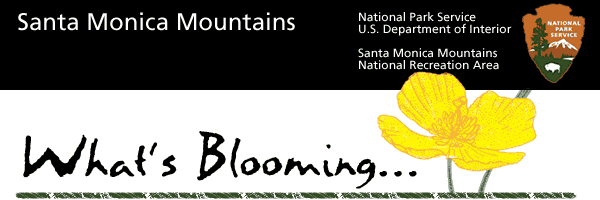

| Available Sites | |
| Malibu Creek State Park Rancho Sierra Vista/Point Mugu State Park Point Mugu State Park/La Jolla Canyon Paramount Ranch Topanga State Park |
Revised: 6/06/04 |
| Rancho Sierra Vista / Point Mugu State Park | Upper Sycamore Canyon Trail | Date Observed: |
| The last spring blooms are fading fast, but early summer varieties
have a good jump on the season. Most of the 30 flower species were seen
in the canyon bottom, where lush undergrowth is nicely-shaded by large oaks
and sycamores. Pitcher sage, sticky monkey flower, chicory, speckled clarkia,
branching phacelia, 3 everlastings, and bush mallow were scattered
among abundant heartleaf penstemon. Many of the spring bloomers
have gone to berries including sugarbush, elderberry, redberry,
and blackberry. A few other notables up top were collarless CA poppies,
laurel sumac, soap lilies (in afternoon bloom), gumplant, bush
sunflowers, plus ashy-leaf and |
||
| Naturalist's rating: Fair | ||
| Malibu Creek State Park | Crags Road to the Mash Site | Date Observed: |
| This hike has
a lot of shade and a fair to good display of flowers. Starting from the
furthest parking lot, follow the signs for Backcountry Trails. Just beyond
the new plantings of oak trees, |
||
| Naturalist's rating: Fair to Good | ||
| La Jolla Valley Loop Trail | Date Observed:5/28/04 | |
| We started off the PCH at the
Chumash Trail. We were greeted at the trailhead by two deer
who quickly disappeared into the brush. Some 55
different species (including the grasses and rushes) were found to be in
bloom. For variety this gets a good rating and for quantity a fair rating.
Of particular interest was a yellow flower growing in the water adjacent
to some water cress, which was later identified as the genus Ranunculus,
possibly R. auricomus. The white/cream color group
had the largest number in flower and included Calif. Buckwheat, felt-leaf
everlasting, Calif. Everlasting, ashy-leaved buckwheat, horehound, So. Calif.
Locoweed (flowers and pods) and morning glory. Also seen was
elderberry, narrow-leaved milkweed, laurel sumac, chamise,
mulefat, cliff aster, yarrow, white nightshade
and watercress. With only one fewer than the white group, the yellow/golden group provided in addition to the Ranuncula: hedge mustard, deerweed, golden yarrow, slender tarweed, prickly pear, narcescent dudleya, bush monkeyflower, gum plant, black mustard, golden stars, yellow star thistle, prickly lettuce, sow thistle, and canyon sunflower. Seen in the lavender/purple/blue color group was bush mallow, black sage, purple sage, vervain, cardoon, red stem filaree, Italian thistle, bull thistle, blue-eyed grass, Calif. Figwort, and rigid hedge nettle. The pink and red group contributed coast paintbrush, Indian pink, wild rose, heart leaved penstemon, and scarlet pitcher sage. Other sightings were stinging nettle, fountain grass, Harding grass, lemonade berry (unusually bright orange to red berries), giant bulrush ( Tule), iris-leaved rush, and |
||
| Naturalist's rating: Fair to Good | ||
| Coyote Canyon Trail | Date Observed:5/28/04 | |
| We started off the PCH at the
Chumash Trail. We were greeted at the trailhead by two deer
who quickly disappeared into the brush. Some 55
different species (including the grasses and rushes) were found to be in
bloom. For variety this gets a good rating and for quantity a fair rating.
Of particular interest was a yellow flower growing in the water adjacent
to some water cress, which was later identified as the genus Ranunculus,
possibly R. auricomus. The white/cream color group
had the largest number in flower and included Calif. Buckwheat, felt-leaf
everlasting, Calif. Everlasting, ashy-leaved buckwheat, horehound, So. Calif.
Locoweed (flowers and pods) and morning glory. Also seen was
elderberry, narrow-leaved milkweed, laurel sumac, chamise,
mulefat, cliff aster, yarrow, white nightshade
and watercress. With only one fewer than the white group, the yellow/golden group provided in addition to the Ranuncula: hedge mustard, deerweed, golden yarrow, slender tarweed, prickly pear, narcescent dudleya, bush monkeyflower, gum plant, black mustard, golden stars, yellow star thistle, prickly lettuce, sow thistle, and canyon sunflower. Seen in the lavender/purple/blue color group was bush mallow, black sage, purple sage, vervain, cardoon, red stem filaree, Italian thistle, bull thistle, blue-eyed grass, Calif. Figwort, and rigid hedge nettle. The pink and red group contributed coast paintbrush, Indian pink, wild rose, heart leaved penstemon, and scarlet pitcher sage. Other sightings were stinging nettle, fountain grass, Harding grass, lemonade berry (unusually bright orange to red berries), giant bulrush ( Tule), iris-leaved rush, and |
||
| Naturalist's rating: Fair | ||
| Los Liones Trail | Date Observed:5/12/04 | |
| This trail is accessed from |
||
| Naturalist's rating: Fair | ||
| Contact Information: 401 West Hillcrest Drive Thousand Oaks, CA 91360 Ph. 805-370-2301 web. www.nps.gov/samo |
Thank you for your contributions: Jack Gillooly Robert W. Maughmer Burt Elliott |
If you would like to contribute to the wildflower report: e-mail: sheila_braden@nps.gov or phone her at 805-370-2394 |